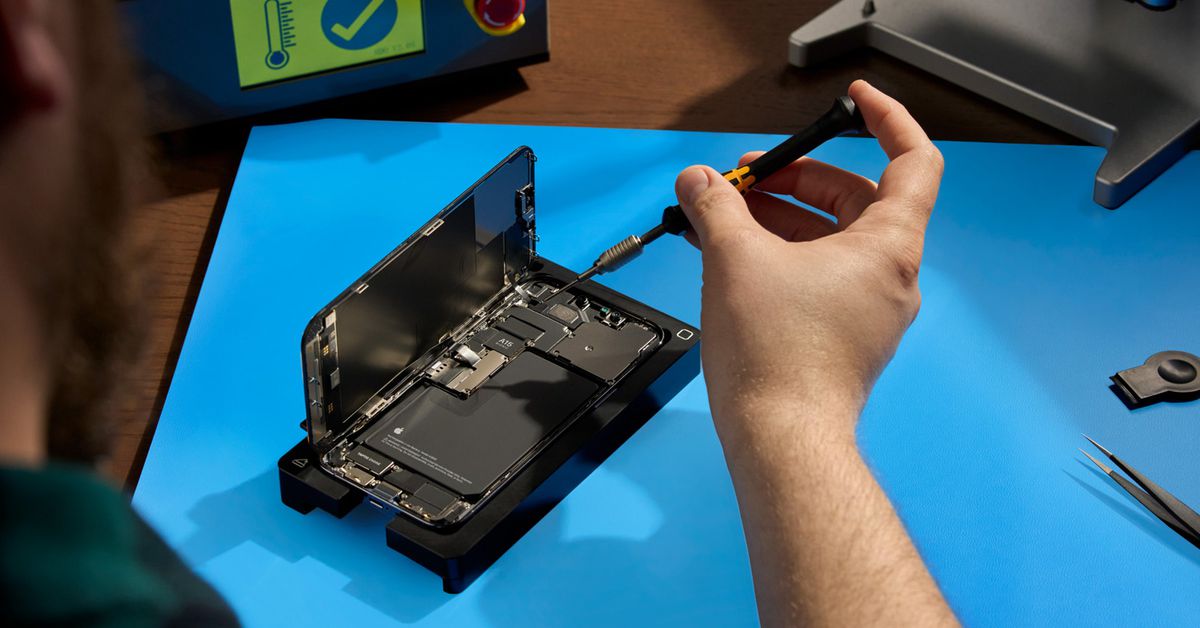- cross-posted to:
- technews@radiation.party
- news_tech@lemmy.link
- technews@radiation.party

Those watches are very heavy though.

Does this really need an explanation?
-
Non-replaceable batteries provide zero benefits.
-
Swappable batteries allow you to just carry extras instead of being tethered to a charger. I used to literally never plug my phone in. Just swap batteries one or twice a day.
-
It’s the first component to die in most phones, and people can’t be bothered or don’t realize you can have them replaced, so they just throw them in the garbage. That’s why they started doing it in the first place.

Note to nr. 2, this does not mandate builds where you can just pull off the back, take the battery out and put a new one in. They can still require basic tools to open, but requiring specialized tools or glueing it shut isn’t allowed.

That’s fair, but some don’t want to be able to swap out the batteries on demand, we just want to be able to replace a worn one every few years for less than $100. USB power is so ubiquitous these days that having access to quick charging isn’t an issue for most people, and Qi is pretty convenient.

Again, there is no trade-off. If you want to just plug your phone in and be tethered to a wall, you can still do that.
-

Having read a little more detail, I still think this is a fantastic decision and long overdue.
Even if you have to remove 6 torx screws to get the rear cover off and then replace a rubber gasket before putting everything back together- the necessary change in build materials and construction will result in a more durable, longer lasting device.

It feels like this fight is 5-7 years late. I am glad the EU actually tries to regulate on behalf of the consumer vs what the US has been doing lately(almost nothing), but the EU does it in a ham-handed way half the time.
I don’t necessarily want a user replaceable battery on my phone. I prefer it not be chonky and I prefer it to be water and dust proof. All of those features impact me sooo much more than being able to change the battery.
Also batteries have come so far this past decade it almost seems like a non issue.

and I prefer it to be water and dust proof.
Adding replaceable batteries does nothing to affect this. An o-ring with a clamping mechanism will make it just as water and dust resistant as before. Your phone’s charging port is more susceptible to water and dust than a replaceable battery will ever be

Also batteries have come so far this past decade it almost seems like a non issue.
I’ve actually have the opposite experience. I didn’t mind integrated batteries a decade ago, because the hardware improved at such a fast pace that it became obsolete before the battery gave up.
But now the hardware improvements are not so fast and a decent phone will be usable for many years, at which point the battery (at least for me) is the first point of failure.
I would much rather take battery replacement over some water and dust protection as ip54 should be enough for daily use (fairphone 4 for instance does have ip54). The only time I’ve needed more protection is when I needed to take family photos in a pool

That’s a really solid point. I guess it depends on the phone. The low end Android market probably isn’t holding up as well as the high end or iphones.
My pixels seem to last as long as it takes for me to pay them off before they just black screen and brick themselves. I had 3 pixel threes, since two replaces under warranty and the last one died a few weeks outside.
Meanwhile my wifes iphone was just fine. She only changed because her dad got the latest and greatest and handed down this last-year model to her. So I could see batteries being an issue over time.

One article about that topic that finally mentions it: There is a descriptive sentence is the resolution that exempts devices with water proofing from it.
As I saw in the past, there were lots of hype posts and what manufacturer X, Y or Z is going to do now. Most of the high-end phones already have an IP-rating, haven’t they? Well, there is the answer. They just keep what they have been selling and it already complies with this new resolution.

To quote the actually adopted text:
(38) […] A portable battery should be considered to be removable by the end-user when it can be removed with the use of commercially available tools and without requiring the use of specialised tools, unless they are provided free of charge, or proprietary tools, thermal energy or solvents to disassemble it […]
(39) To ensure the safety of end-users, this Regulation should provide for a limited derogation for portable batteries from the removability and replaceability requirements set for portable batteries concerning appliances that incorporate portable batteries and that are specifically designed to be used, for the majority of the active service of the appliance, in an environment that is regularly subject to splashing water, water streams or water immersion and that are intended to be washable or rinseable. This derogation should only apply when it is not possible, by way of redesign of the appliance, to ensure the safety of the end-user and the safe continued use of the appliance after the end-user has correctly followed the instructions to remove and replace the battery. Where the derogation applies, the product should be designed in such a way as to make the battery removable and replaceable only by independent professionals, and not by end-users.
This is absolutely not the same as having an IP rating. A portable toaster could have an IP rating, but that doesn’t mean it’s intended to be submersed a lot in its life time.

The difference is that we are talking about mobile phones and tablets here. A manufacturer can easily argue his device is intended for water immersion or intended to be washable. And the exception is fulfilled.
I mean they don’t really have to argue to begin with, they just keep selling their IP-rated phones as they are. Only if someone starts a motion that this would not be legal, then they can start the argument I mentioned above. And that’s all it takes.

A manufacturer can easily argue his device is intended for water immersion or intended to be washable. And the exception is fulfilled.
But the text says:
to be used, for the majority of the active service of the appliance
While a phone might be intended to be able to withstand rain and slight immersion, its not intended to be used in such an environment for the majority of its active service. Nobody is actually going to believe that imo.
Only if someone starts a motion that this would not be legal, then they can start the argument I mentioned above. And that’s all it takes.
For some time now the EU has shown a willingness to bite tech companies in such matters. I hope the EU keeps doing that and extends that willingness. But yeah, for now we can only guess. Although I do think manufacturers wont try to weasel out of this, and if they do, i hope they get bitten.

I think it’s telling that most manufacturers won’t do warranty for water damage despite advertising a suitable IP rating. From a legal standpoint that seems to show that the above clauses wouldn’t apply, and if the manufacturer did want to use those clauses to get around the removable battery thing then they’d probably have to start accepting water damage as covered by warranty.

Most phones are IP68 which means “immersed in water under conditions which shall be agreed between the manufacturer and user”.
For Apple, that means “accidental” immersion in water and it’s also not a “permanent” feature - the glue that keeps water out can be damaged with normal phone use.

the main benefit of this, is that you can self-replace the battery when it becomes excessively degraded and doesn’t hold charge as good as a healthy battery. otherwise you’d still need a power-bank for your other tech, such as AirPods or similar stuff.

Watches have been 50m/100m water proof for years with replaceable off the shelf button batteries. You just unscrew the back, replace the battery, make sure the seal isn’t damaged and in it’s little track and screw it back on.
This is seriously not rocket science.

Those screw in backs add a few millimetres of thickness to the watch. They also need to be made from thick heavy materials like stainless steel. When you make them out of lighter materials, like plastic, they are far thicker.
It’s not rocket science, but it is a challenging problem and one that can only be solved with compromises. Personally I’m fine with those compromises, but you’re kidding yourself if you think anyone is going to buy a smartphone with a 4mm thick steel battery cover.
What’s probably going to happen is phones will have a screw on cover with a weak adheisve that will be destroyed when you replace the battery. You’ll need to remove the adhesive and apply new adhesive if you want to maintain water resistance.
Also - watches aren’t compliant are they? You can’t take the back off a watch with a screwdriver. Dive watches would fall under the “designed to be submerged” exemption, but regular watches willl probably ahve to switch to being held in with screws instead of a screw in back - and a lot of currently waterproof watches will become water resistant.


